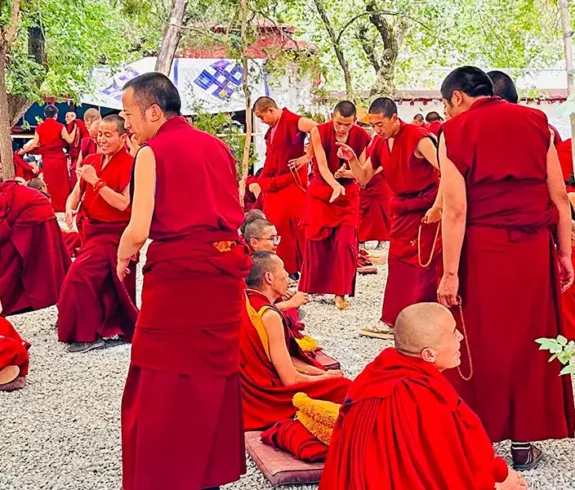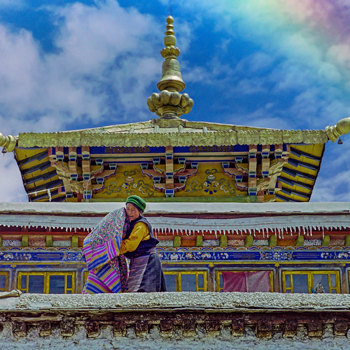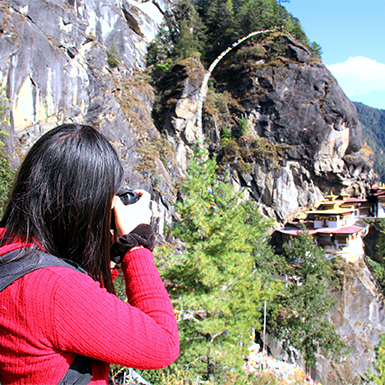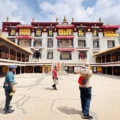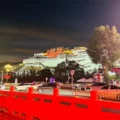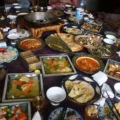Monasteries of Tibet transcend their architectural grandeur. These spiritual sanctuaries are the lifeblood of Tibetan Buddhism, serving as centers of worship, learning, and cultural preservation for centuries. Monks dedicate their lives here, studying Buddhist philosophy, performing rituals, and upholding traditions passed down through generations.
This article focuses on three significant monasteries: Sera Monastery, Drepung Monks, and Ganden Monastery. Each boasts a unique history, character, and vital role within Tibetan Buddhism.
Historical Significance of Sera, Drepung, and Ganden Monasteries
Tibetan Buddhist monasteries are not just architectural marvels but testaments to a rich history and profound spiritual tradition. Each monastery boasts a unique founding story and has played a pivotal role in shaping Tibetan Buddhism. Let’s delve into the fascinating past of these three prominent landmarks:
1. Sera Monastery: A Hub of Debate and Learning (Founded 1419)
Established by Jamchen Chojey, a disciple of the revered Je Tsongkhapa, Sera Mey Monastery rapidly gained prominence as a center for Buddhist scholarship.
The monastery’s enduring legacy lies in its vibrant tradition of public debates. Monks engage in spirited discussions on Buddhist philosophy, sharpening their debating skills and deepening their understanding of the teachings.
This unique practice, a cornerstone of Sera Mey’s monastery identity, has captivated visitors for centuries, offering a glimpse into the intellectual side of Tibetan Buddhism.

2. Drepung Monastery: Once the World’s Largest (Founded 1416)
Drepung Monks holds the remarkable distinction of once being the world’s largest monastery. Founded by Jamyang Chojey, another disciple of Je Tsongkhapa, it housed a vast community of monks dedicated to studying and practicing Tibetan Buddhism.
The sprawling complex encompassed numerous colleges, each specializing in a specific aspect of Buddhist doctrine. This specialization fostered a deep understanding of the religion’s vast teachings.
Beyond its academic influence, Drepung Monastery played a significant role in Tibetan politics. The monastery’s abbots wielded considerable influence, and the Fifth Dalai Lama, a revered figure in Tibetan Buddhism, was known to have a particular fondness for this monastery.
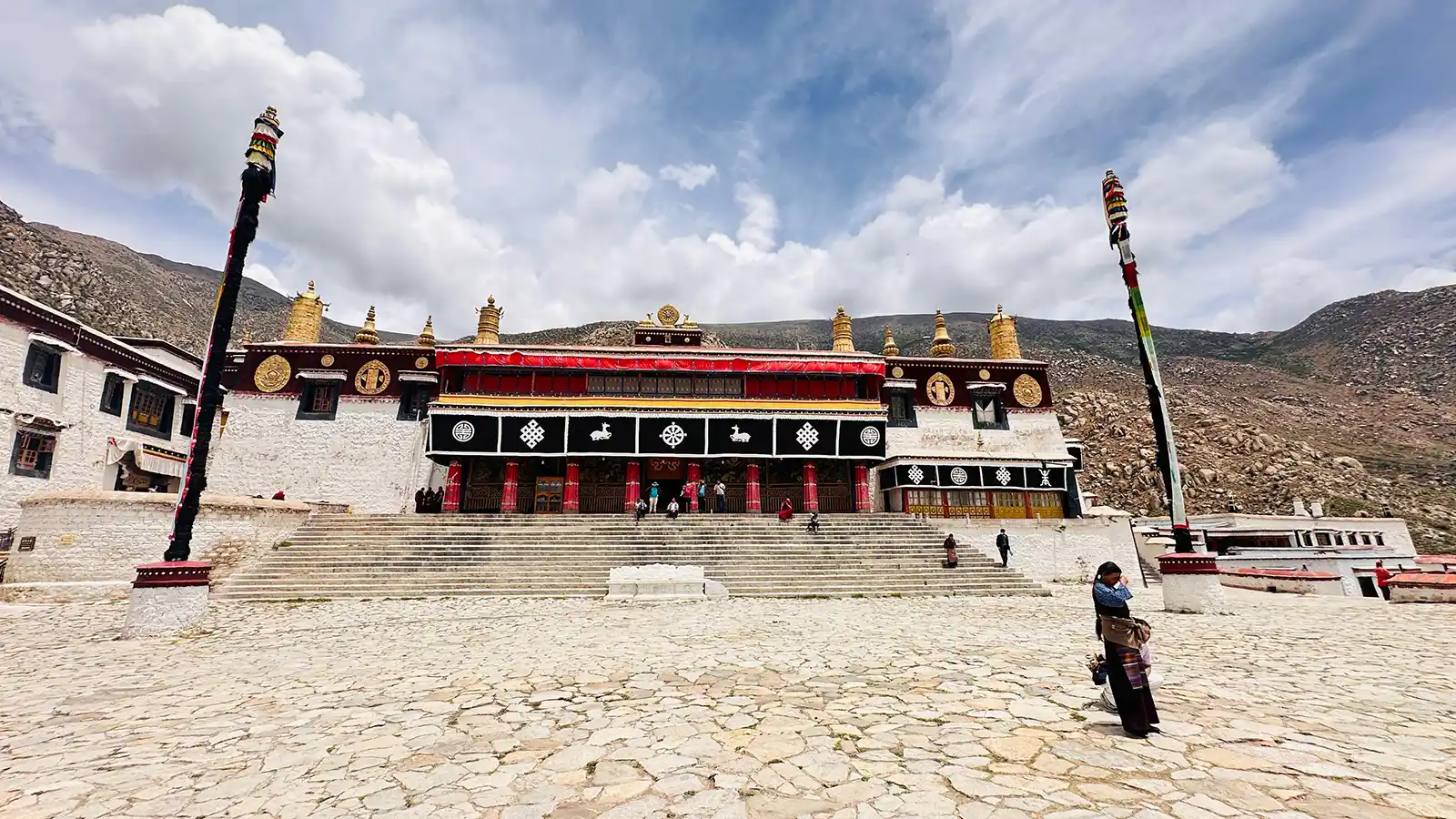
3. Ganden Monastery: The Gelugpa School’s Holiest Site (Founded 1409)
Founded by Je Tsongkhapa himself, Gan Den Monastery holds immense significance for the Gelugpa school of Tibetan Buddhism. It served as Tsongkhapa’s primary residence and the birthplace of the Gelugpa tradition.
The monastery’s serene setting atop Wangbur Mountain adds to its spiritual aura. Interestingly, Gan Den Monastery’s architectural style deviates from the other two, featuring smaller buildings clustered around the central Tsochin Hall.
After Tsongkhapa’s passing, his preserved body was interred at Gan Den Monastery, further solidifying its status as the holiest site for the Gelugpa school.
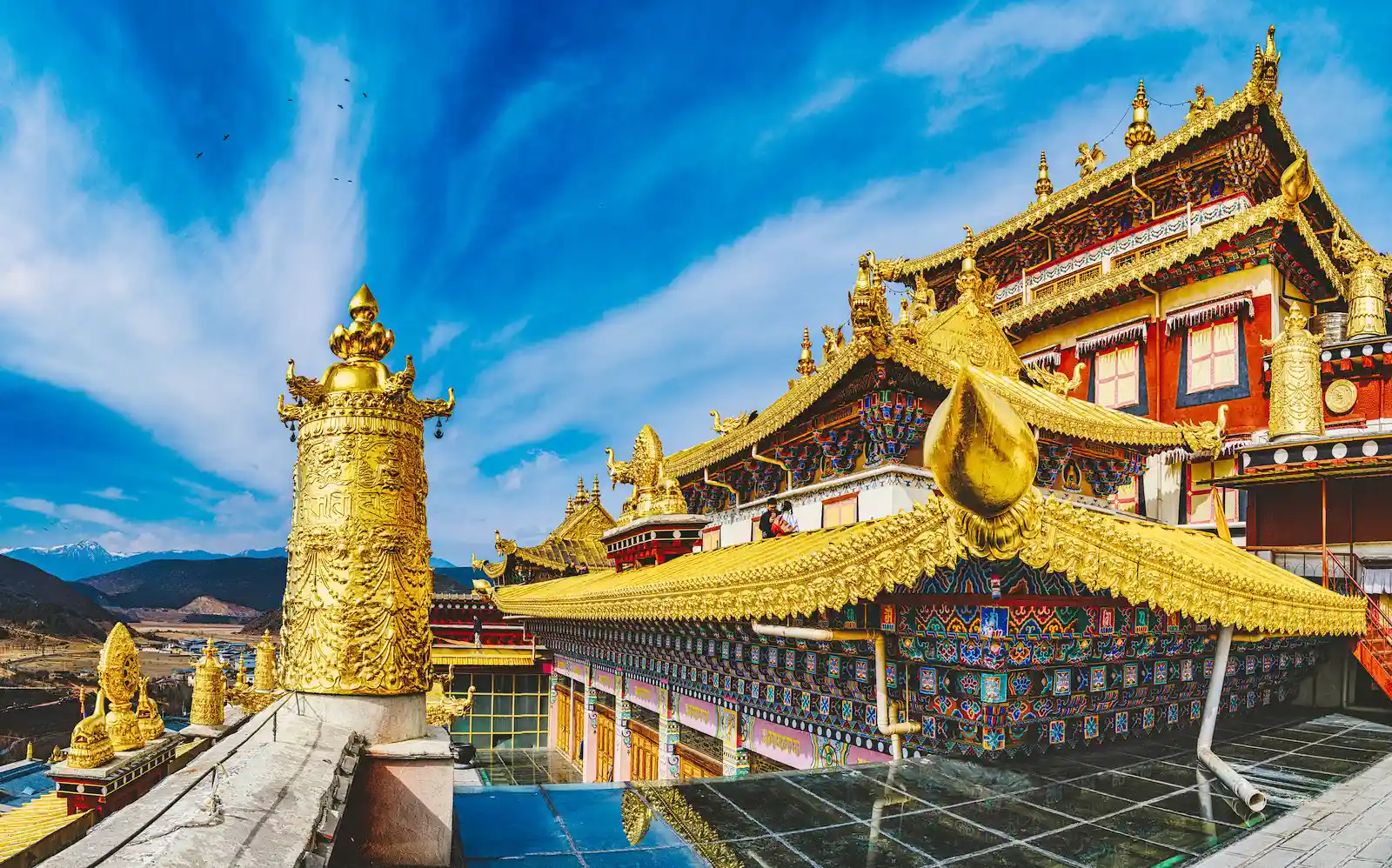
Architectural Splendor: A Look at the Design of Each Monastery
The monasteries of Tibet are not just spiritual centers but also stunning examples of Tibetan architecture. Each “Great Three” boasts unique features that reflect their grandeur and functionality.
Sera Monastery:
- Densely Packed Buildings: Sera Monastery features a maze-like complex with closely stacked buildings, unlike its sprawling counterparts. This design fosters a sense of community and efficiently utilizes the hillside space.
- Assembly Halls: The most prominent structure is the Tsokchen, or Coqen Hall, a four-story building with a grand entrance portico. Inside, visitors can find chapels adorned with statues of important figures like Shakyamuni Buddha and Tsongkhapa, the founder of the Gelugpa school.
Drepung Monastery:
- Imposing Scale: Drepung Monks is the largest of the three, boasting an expansive complex that once housed over 10,000 monks. The buildings rise in tiers, with the most critical structures, like the Coqen Hall, positioned at the highest point.
- Golden Rooftops: A distinctive feature of Drepung is the use of gilded roofs on significant buildings. This element adds a touch of luxury and reflects the reverence held for these structures.
- Prayer Wheels: Scattered throughout the complex are numerous prayer wheels, a hallmark of Tibetan Buddhist practice. Pilgrims spin these wheels to accumulate merit and send prayers outward.
Ganden Monastery:
- Majestic Mountaintop Setting: Perched atop Wangbur Mountain, Gan Den Monastery contrasts the other two. After their climb, visitors enjoy breathtaking views of the surrounding valleys.
- Central Courtyard Design: Unlike the maze-like layout of Sera, Ganden features a more open plan centered around a large courtyard. It allows for a more spacious and airy feel.
- Unique Artistic Elements: Keep an eye out for intricate murals depicting Buddhist deities and stories adorning the walls of the monastery buildings. These vibrant artworks offer a glimpse into Tibetan artistic traditions.
Unveiling the Spiritual Heart: Daily Life, Ceremonies, and Teachings in Tibetan Monasteries
Tibetan Buddhist monasteries are not just architectural marvels but vibrant centers of cultural and religious practice. Monks residing here dedicate their lives to a structured routine of prayer, study, and upholding traditions. Let’s delve into the daily routines, special ceremonies, and teachings that occur within the walls of Sera, Drepung, and Ganden monasteries:
Daily Routines:
- The monks of the three monasteries adhere to a rigorous daily routine that centers on prayer, meditation, and study.
- Mornings typically begin with group prayers, chanting, individual meditation sessions, and breakfast.
- The afternoons are dedicated to religious studies, often involving debates or lectures depending on the monastery’s specific focus.
- Evenings may involve further prayers or communal activities.
Special Ceremonies:
- Each monastery hosts unique festivals and ceremonies throughout the year.
- Sera Mey monastery is mainly known for its Monlam Prayer Festival, a vibrant celebration featuring masked dances and intricate mandala offerings.
- Drepung Monks celebrate the Shoton Festival, a lively event with traditional Tibetan yogurt-eating competitions and theatrical performances.
- Ganden Monastery participates in the Lhabab Duchen festival, which honors the Buddha’s conception, enlightenment, and parinirvana (death).
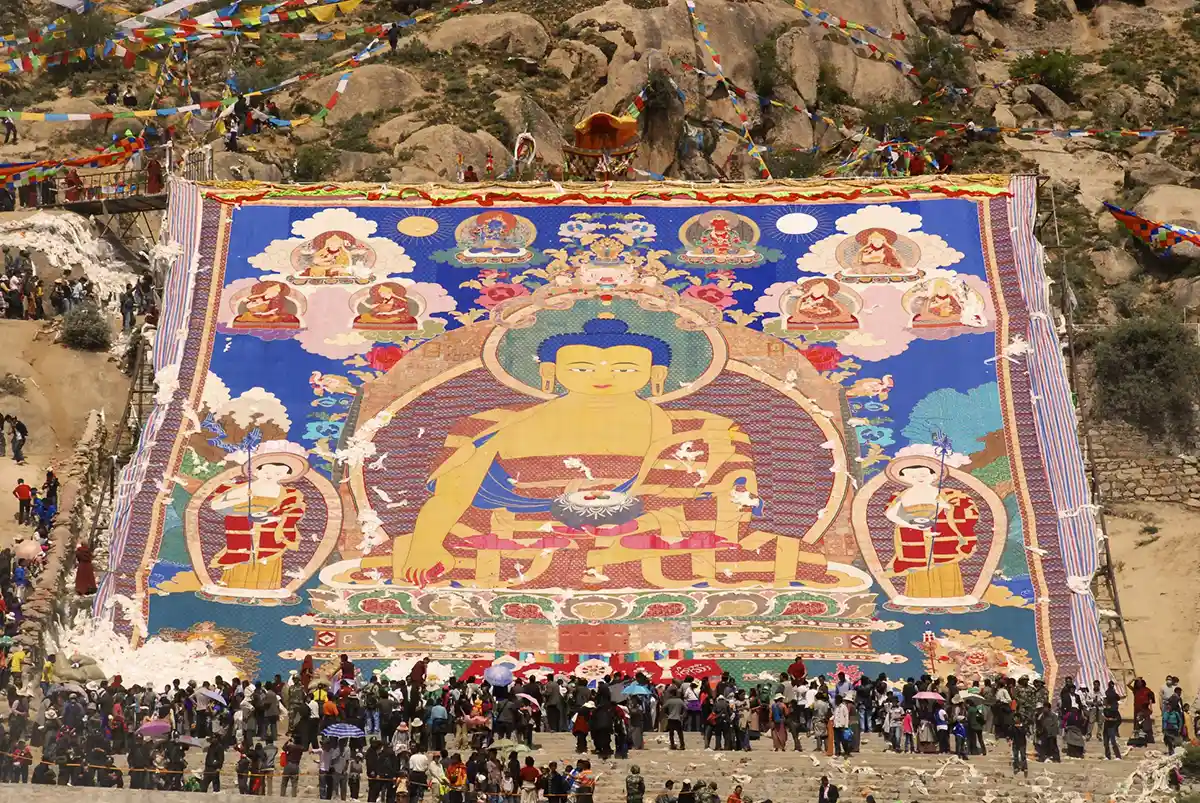
Teachings and Education:
All three monasteries play a vital role in training future generations of monks.
Sera Mey monastery emphasizes dialectical debate, honing the monks’ understanding of Buddhist philosophy through rigorous discussions.
Drepung Monastery, with its numerous colleges specializing in various aspects of Buddhism, offers aspiring monks a comprehensive education.
Gan Den Monastery is the holiest site for the Gelugpa school, which focuses on teachings specific to that tradition.
Monks as Custodians of Culture:
- Beyond their religious significance, Tibetan Buddhist monasteries serve as cultural repositories.
- Monks meticulously preserve ancient Tibetan texts, art forms, and traditions to ensure their survival for future generations.
A Visitor’s Guide to Sera, Drepung, and Ganden Monasteries
Tibetan Buddhist monasteries are popular tourist attractions in addition to being spiritual havens. Proper planning and etiquette allow visitors to experience these sacred places’ tranquility and rich culture. Here’s a guide for exploring Sera, Drepung, and Ganden monasteries:
Planning Your Visit:
- Permits: A Tibet Travel Permit is mandatory for foreign visitors. Obtain this through a travel agency authorized to handle foreign tourists in Tibet.
- Best Time to Visit: Spring (April-May) and autumn (September-October) offer pleasant weather. Avoid the monsoon season (July-August) and harsh winters.
- Tours: Consider taking one of the informative tours given by local experts, who can discuss the significance, history, and customs of each monastery.
Respectful Etiquette:
- Dress modestly: Wear comfortable clothing and cover your knees and shoulders when walking on uneven terrain.
- Photography: Some areas may restrict photography. Always seek permission before photographing monks or religious ceremonies.
- Monastery Etiquette: Speak softly, avoid pointing at statues or religious figures, and walk clockwise around the monastery complex.
Visiting Each Monastery:
- Sera Monastery: Located near Lhasa, Sera is easily accessible and has minimal entrance fees. Typically, in the mornings, witness the fascinating debates in the Dratsang courtyard.
- Drepung Monastery: Also near Lhasa, Drepung offers a vast complex to explore. Entrance fees apply. Time your visit to coincide with the Shoton Festival (usually in July) for a truly unique experience.
- Ganden Monastery: Located further away, Ganden requires more planning and transportation arrangements. Entrance fees are present. Enjoy the serene mountain setting and explore the Tsochin Hall, the architectural centerpiece.
Whispers of the Past: Legends and Stories from the Monasteries
The monasteries of Tibet are not just architectural and cultural marvels but also repositories of ancient legends and personal stories illuminating their rich history.
Sera Mey Monastery:
- Echoes of Debate: Legend tells of a talented young monk from Sera who consistently defeated his opponents in debate. One day, an old, weathered traveler challenged him. Despite his arrogance, the young monk received a sound beating in the discussion. The traveler then revealed himself to be Manjushri, the bodhisattva of wisdom, reminding the young monk of the importance of humility in the pursuit of knowledge.
- A Visitor’s Tale: Many visitors to Sera remark on the lively atmosphere during debate sessions. The energetic hand gestures and booming voices create a unique spectacle, offering a glimpse into the intellectual side of Tibetan Buddhist practice.
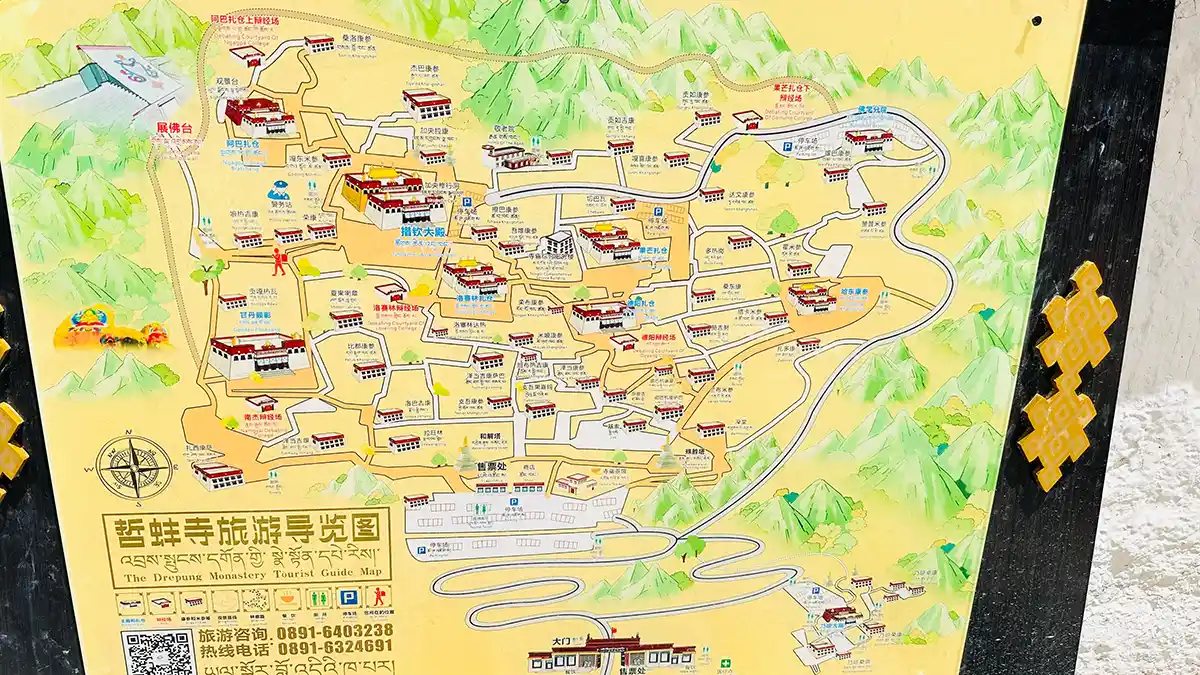
Drepung Monastery:
- The Oracle’s Prophecy: According to legend, an oracle’s prophecy guided the founding of Drepung Monks. The oracle declared that a golden fish would indicate the auspicious location. Following a vision, Tsongkhapa, the founder of the Gelugpa school, identified the current site of Drepung after spotting a fish-shaped rock formation in the valley below.
- A Monk’s Reflection: Monks at Drepung often speak of the sense of peace that permeates the monastery despite its vast size. The routine of prayer, study, and reflection fosters a deep understanding of inner calm, a quality many visitors find themselves drawn to.
Ganden Monastery:
- A Visionary’s Dream: Legend states that Tsongkhapa dreamt of a celestial palace during his meditations. This vision is said to have inspired the design and location of Gan Den Monastery, perched atop Wangbur Mountain. The name Ganden itself translates to “joyful place,” reflecting the beauty and serenity of the monastery’s setting.
- A Traveler’s Account: Travelers often comment on the breathtaking views surrounding Gan Den Monastery. The panoramic vistas of the Himalayas add another layer of wonder to the experience of visiting this sacred site.
Enduring Legacy: The Modern Role and Community Impact on Monasteries of Tibet
Tibetan Buddhist monasteries transcend their historical significance. They continue to be vibrant centers of religious practice, education, and community interaction. Let’s explore how Sera, Drepung, and Ganden monasteries impact the lives of local communities:
Community and Social Hubs:
Monks residing in these monasteries often come from nearby villages. The monasteries provide them with education, housing, and a sense of belonging.
The monks provide the local communities with religious rituals and festivals, which unite people and build social relationships.
Tibetan Buddhist monasteries also serve as centers for traditional Tibetan medicine, offering medical care to those in need.
Preserving Culture and Heritage:
Monks meticulously hand-copy ancient scriptures, preserving Tibetan Buddhist knowledge and traditions for future generations.
The monasteries are repositories of art, music, and architectural styles, safeguarding Tibet’s rich cultural heritage.
Local communities often participate in traditional performances and celebrations at the monasteries, fostering a sense of cultural identity.
Modern-Day Events and Festivals:
Sera Mey Monastery continues its tradition of lively debates, attracting visitors eager to witness this unique intellectual practice.
Drepung Monks still observe the Shoton Festival, a vibrant celebration featuring theatrical performances and traditional yogurt-eating competitions. This event draws large crowds from surrounding communities.
Ganden Monastery hosts the Lhabab Duchen festival, commemorating the Buddha. Local communities participate in offerings and prayers, strengthening their connection to their faith.

Safeguarding the Sacred: Conservation Efforts in Tibetan Monasteries
Tibetan Buddhist monasteries, irreplaceable treasures of cultural and historical significance, face the challenge of preservation in the modern world. Fortunately, dedicated efforts are underway to ensure their continued existence for future generations.
Preserving the Past for the Future:
The Chinese government has implemented programs to restore and maintain major monasteries, including Sera Mey Monastery, Drepung Monks, and Gan Den Monastery.
Local communities are essential to the protection of these holy places. The monks use natural materials and traditional building methods to preserve the monastery carefully.
International organizations such as UNESCO (United Nations Educational, Scientific and Cultural Organization) have also taken an interest in preserving Tibetan cultural history. While none of the three monasteries mentioned here hold a current UNESCO World Heritage designation, other significant Tibetan monasteries are on the list, highlighting the international recognition of their importance.
Sustainable Practices:
Efforts are underway to develop sustainable tourism practices that generate income for the monasteries, allowing them to invest in maintenance and restoration projects.
Monasteries are incorporating eco-friendly practices, such as solar energy and rainwater harvesting, to minimize their environmental impact.
A Trip Through Tibet’s Most Renowned Monasteries
Tibetan Buddhist monasteries are more than just architectural marvels perched amidst breathtaking landscapes. Serving as hubs for worship, education, and cultural preservation for centuries, they represent the lifeblood of Tibetan Buddhism. Each monastery, including Sera Monastery, Drepung Monks, and Ganden Monastery, has a unique history and character that contribute to the rich tapestry of Tibetan culture.
A Legacy of Spirituality and Knowledge
Delving into the historical significance of these monasteries reveals the profound impact of Tibetan Buddhism on the region.
The architectural styles reflect functionality and symbolism, providing a deeper understanding of Buddhist practices.
Daily routines, ceremonies, and teachings followed within the monasteries showcase the dedication of monks and the enduring power of these spiritual traditions.
Beyond the Walls: Community and Culture
Tibetan Buddhist monasteries extend their influence beyond their walls. They serve as:
Community Hubs: Providing education, housing, and a sense of belonging to resident monks while fostering social bonds within local communities.
Cultural Custodians: Preserving ancient scriptures, art forms, and traditional medicine, ensuring their survival for future generations.
A Call to Respectful Exploration
As you plan your visit to these sacred sites, remember:
Respectful Etiquette: Dress modestly, speak softly, and be mindful of religious customs.
Permits and Planning: Obtain necessary licenses and consider guided tours to gain deeper insights.
Responsible Tourism: Choose travel companies like Peregrine Treks and Tours, which commit to sustainable practices that benefit the monasteries and local communities.
